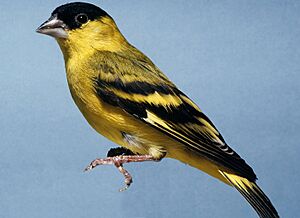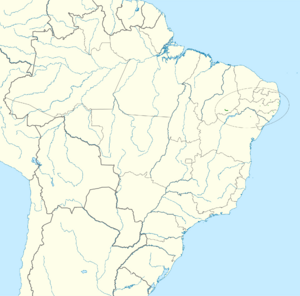Yellow-faced siskin facts for kids
Quick facts for kids Yellow-faced siskin |
|
|---|---|
 |
|
| Conservation status | |
| Scientific classification | |
 |
|
| Synonyms | |
|
Sporagra yarrellii |
The yellow-faced siskin (Spinus yarrellii) is a small, colorful bird. It is part of the finch family, called Fringillidae. You can find this bird living in Brazil and Venezuela.
These siskins live in many different places. Their homes include warm, wet mountains and dry, bushy areas. They also live near farms, in plantations, and even in urban areas. The bird's scientific name, yarrellii, was given to honor an English bird expert named William Yarrell.
Contents
About the Yellow-faced Siskin
The Yellow-faced siskin was first described in 1839. A famous bird artist, John James Audubon, gave it its name. He studied a male bird specimen to learn about it. This bird is part of the Spinus group of finches.
What Does It Look Like?
Yellow-faced siskins look a bit different depending on if they are male or female. This is called sexual dimorphism. Male siskins have a black cap on their head. Both male and female birds have bright yellow bodies. Their backs are olive green, and their wings are a mix of black and yellow. Their legs are pink, and their tail is black on top and white underneath.
Like other birds in its group, the Yellow-faced siskin has a special bill. It is shaped like a cone. This helps the bird hold and open seeds, which are a big part of its diet. The amount of black on a male's head can change. Some males might also have black around their eyes and ears. Their calls are pretty and sound like a song. They are similar to the calls of other finches, like the Pine siskin.
Where Do They Live?
The Yellow-faced siskin lives in different spots across southeastern Brazil. You can find them in states like Ceará, Paraíba, Pernambuco, Piauí, and Bahia. There is also a group of these birds far away in northern Venezuela. Some experts think these Venezuelan birds might have escaped from cages. However, people found wild Yellow-faced siskins there as early as 1914.
What Do They Eat and How Do They Live?
The Yellow-faced siskin mainly eats small seeds. But they also enjoy berries and insects. Their nests are shaped like a cup. They build them using things like grasses, spider webs, and animal hairs. Even though they live in a small area, they can be found in many different places. These include dry forests called caatinga, city areas, forest edges, and coffee farms.
Why This Bird Needs Help
The Yellow-faced siskin is currently listed as a vulnerable animal. This means it is at risk of becoming endangered. The main reason for this is the illegal bird trade. People catch these birds to sell them as pets. This, along with forests being cut down, is a big danger to the siskins. Even though the bird has always been somewhat popular, more trapping since the 1980s has caused their numbers to drop a lot.


